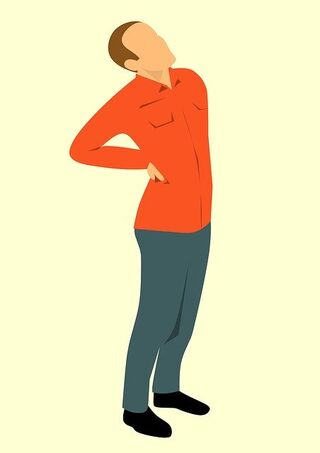Chronic Pain
Pain Catastrophizing and Exercise Avoidance: A Vicious Circle
New research suggests a valuable target for interventions to treat chronic pain.
Posted August 30, 2020 Reviewed by Matt Huston

Chronic pain is pain that lasts more than several months, defined as 3 to 6 months or longer. Chronic pain can last years, eluding anything resembling a “cure.” The CDC reported that in 2016 it was estimated over 20 percent of US citizens—50 million people—reported chronic pain, costing around $560 billion per year (1). Chronic pain is among the most common reasons adults seek medical care (2), has been linked to restrictions in mobility and daily activities (3,4), dependence on opioids (5), anxiety and depression (3), and poor perceived health or reduced quality of life (3,4)
The most prevalent chronic pain conditions are low-back pain, arthritis pain, headache/migraine, cancer pain, and neurogenic pain (pain resulting from damage to the peripheral nerves or to the central nervous system itself) such as fibromyalgia, as well as pain not due to past disease or injury or any visible sign of nervous system damage. As someone with chronic pain myself (two herniated discs in my lumbar spine), I’m all-too-well acquainted with what an onerous, dogged, and wearying influence it can be on one’s life.
Chronic pain becomes more common as people age, at least in part because health problems that can cause pain, such as osteoarthritis and certain disease conditions, become more common with advancing “chronological maturity.” Military veterans are another group at increased risk for chronic pain by virtue of the residual effects of the often extraordinary physically taxing tasks they have been assigned.
While physical activity is one of the most important self-management strategies for those with chronic pain, many avoid physical activities in which they are actually capable of participating. New research just published in the journal Pain suggests that how people think about their pain can have a significant effect on whether they get enough physical activity (6).
This research focused on a specific type of thinking related to pain: catastrophizing. Catastrophizing about one’s pain instantly brings to mind worst-case scenarios that exaggerate helplessness and hopelessness, and includes thought patterns such as "the pain is horrible,” “I can’t stand it anymore,” “it’s never going to get any better."
This frequently influences those in pain to avoid physical activity and exercise in an effort to also avoid pain, and dovetails with one of the problems that comes with chronic pain—lack of movement. It can hurt to move, and the desire to protect oneself from pain is natural, so movement is often minimized and avoided as much as possible. Unfortunately, the less those with chronic pain move, the more pain they tend to have when they do move, incentivizing them to move even less.
In this study, a team led by researchers at Penn State University analyzed data from 143 older adults with osteoarthritis in their knees. Participants kept daily diaries and wore accelerometers—wearable technology for measuring physical activity—for 22 days. Each morning, participants reported how they felt about their pain that day and the accelerometer gathered information on physical activity and sedentary behavior.
The study found that on mornings when participants catastrophized about their pain more than usual, they engaged in less physical activity later that day. Additionally, catastrophizing about pain in the morning led to more time spent in sedentary behavior throughout that day and the following day. This dynamic contributed to a vicious circle in which more time spent sedentary led to increased pain catastrophizing the following day.
"One particularly interesting finding is that the detrimental influence of catastrophizing thinking about pain is independent of the pain experience itself," said assistant research professor Ruixue Zhaoyang. "In other words, how patients think about their pain, rather than the level of experienced pain, had a more powerful impact on their daily physical activity." Further, as reported by Lynn Martire, professor of human development and family studies, the study demonstrated that pain-related catastrophic thinking can change from day to day and can be modified by everyday activity and behavior.
Reducing pain catastrophizing has the potential to help people with chronic pain to be more physically active and less sedentary, and in turn, improve their chronic pain condition, physical function, and overall health and quality of life, as well as reduce the possibility of hospitalization and healthcare costs in the long-term.
While this study looked specifically at people with knee osteoarthritis, catastrophizing can happen with any form of chronic pain. The results have valuable implications for pain management and wellness, not only for older adults, but also for anyone challenged with chronic pain.
This research suggests that although chronic pain obviously isn’t just in one’s head, what’s in one’s head might have a significant influence on one’s experience of chronic pain. As a result, pain catastrophizing presents an important therapeutic target for mind-body interventions that help people increase their level of physical activity and live better with the chronic pain they experience.
References
Dahlhamer J, Lucas J, Zelaya, C, et al. Prevalence of Chronic Pain and High-Impact Chronic Pain Among Adults — United States, 2016. MMWR Morb Mortal Wkly Rep 2018;67:1001–1006. DOI: http://dx.doi.org/10.15585/mmwr.mm6736a2external icon.
Schappert SM, Burt CW. Ambulatory care visits to physician offices, hospital outpatient departments, and emergency departments: United States, 2001–02. Vital Health Stat 13 2006;13:1–66. PubMedexternal icon
Gureje O, Von Korff M, Simon GE, Gater R. Persistent pain and well-being. A World Health Organization study in primary care. JAMA 1998;280:147–51. CrossRefexternal icon PubMedexternal icon
Smith BH, Elliott AM, Chambers WA, Smith WC, Hannaford PC, Penny K. The impact of chronic pain in the community. Fam Pract 2001;18:292–9. CrossRefexternal icon PubMedexternal icon
Institute of Medicine. Relieving pain in America: a blueprint for transforming prevention, care, education, and research. Washington, DC: National Academies Press; 2011.
Ruixue Zhaoyang et al, Daily pain catastrophizing predicts less physical activity and more sedentary behavior in older adults with osteoarthritis, Pain (2020). DOI: 10.1097/j.pain.0000000000001959




